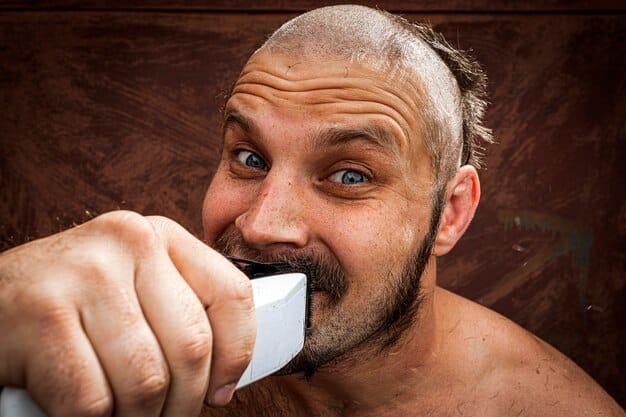Is Your Beard Oil Expired? How to Tell and Why It Matters for Your Skin’s Health

Understanding whether your beard oil has expired is crucial for maintaining both the vitality of your beard and the health of the underlying skin, as rancid oils can lead to irritation, breakouts, and diminished results.
For many, a well-groomed beard is a statement of style and dedication. Yet, in the pursuit of the perfect beard, one often overlooks a critical factor: the freshness of the very product designed to nourish it. Is your beard oil expired? How to tell and why it matters for your skin’s health are questions that deserve a closer look, as even premium products have a shelf life that impacts their efficacy and your skin’s well-being.
The Science of Shelf Life: Why Beard Oil Expires
Understanding why beard oil expires is foundational to appreciating the importance of checking its freshness. At its core, beard oil is a blend of carrier oils (such as jojoba, argan, or almond oil) and essential oils (like tea tree, sandalwood, or lavender). These natural ingredients, while beneficial, are not impervious to the passage of time or environmental factors. They are organic compounds that, like any other, undergo chemical changes leading to degradation.
The primary culprit behind oil expiration is oxidation. This is a natural process where oxygen molecules react with the fatty acids present in the carrier oils. This reaction breaks down the oil’s molecular structure, leading to a host of undesirable changes. Heat, light, and exposure to air accelerate this oxidative process significantly. For instance, storing your beard oil in a sunny bathroom or leaving the cap off can drastically shorten its lifespan compared to keeping it in a cool, dark cabinet.
Understanding Carrier Oils and Their Stability
Carrier oils form the bulk of any beard oil formulation, and their stability varies widely. Some oils, like jojoba oil, are technically waxes and are highly resistant to oxidation, giving products containing them a longer shelf life. Others, such as sweet almond oil or grapeseed oil, are rich in polyunsaturated fats, making them more susceptible to rancidity.
- Jojoba Oil: Highly stable, resembling the skin’s natural sebum, making it less prone to oxidation.
- Argan Oil: Contains antioxidants that help prolong its shelf life, but it can still degrade over time.
- Sweet Almond Oil: More prone to rancidity due to its higher content of polyunsaturated fatty acids.
- Grapeseed Oil: Very light and easily absorbed, but also highly susceptible to oxidation.
The selection of carrier oils by a manufacturer plays a significant role in the overall shelf life of the final product. Brands committed to quality will often balance highly stable oils with those that offer specific skin or hair benefits, sometimes adding natural antioxidants like vitamin E to further extend freshness.
The Role of Essential Oils and Additives
While carrier oils are the main concern for rancidity, essential oils also have their own shelf lives, though they generally last longer than carrier oils when stored properly. Citrus essential oils, for example, are known to degrade more quickly than woody or resinous essential oils. As essential oils oxidize, their aromatic profile can change, and they may lose their therapeutic properties or even become irritating to the skin.
Some beard oils also contain synthetic fragrances or preservatives. While synthetic fragrances don’t ‘spoil’ in the same way natural oils do, their scent can become distorted. Preservatives, on the other hand, are designed to inhibit microbial growth and extend product shelf life, acting as a crucial barrier against spoilage. However, even these have their limitations, and once their efficacy wanes, the product becomes vulnerable.
Ultimately, the expiration of beard oil is not a simple matter of a fixed date but a complex interaction of its natural components with environmental factors. Being aware of these underlying mechanisms empowers you to make more informed decisions about storing and using your grooming products.
Key Indicators: How to Tell if Your Beard Oil is Expired
Detecting an expired beard oil isn’t always as obvious as a moldy piece of bread, but there are several tell-tale signs to look for. Trusting your senses is often the best approach, as changes in scent, texture, and appearance are direct indicators of degradation. Ignoring these signs can lead to ineffective product use and potential skin issues.
The Smell Test: A Primary Indicator
The most unmistakable sign of expired beard oil is a change in its scent. Fresh beard oil typically has a pleasant, often subtle, aroma derived from its essential oils and natural base. As it degrades, particularly due to rancidity, carrier oils develop a distinctly unpleasant smell. This scent is often described as:
- Waxy or Crayola-like: A distinctive, stale odor reminiscent of old crayons or stale cooking oil.
- Sour or Acidic: A sharp, slightly vinegary smell that indicates the breakdown of fatty acids.
- Metallic: Sometimes, the oxidation process can produce a subtle metallic aroma.
If your beard oil no longer smells like the fresh, aromatic product you initially purchased, but instead carries any of these off-notes, it’s a strong indication that it has gone rancid. The aromatic profile from essential oils may also diminish or warp, but the rancid smell of the carrier oils is the clearest sign of spoilage.
Visual Cues: Color and Clarity Changes
Beyond smell, visual changes in your beard oil can also signal its expiration. While some natural variations in color are normal between batches or due to the settling of ingredients, a drastic change usually indicates degradation.
- Darkening: Many oils will naturally darken slightly over time as they oxidize. If your usually pale or golden oil has taken on a significantly darker, brownish, or murky hue, it’s a red flag.
- Cloudiness or Sediment: Fresh beard oil should generally be clear and free of particles. If you observe cloudiness, haziness, or an accumulation of sediment at the bottom of the bottle, it could be a sign of bacterial growth or the breakdown of ingredients. This is particularly concerning as it indicates potential contamination.
Always pour a small amount of the oil onto a clear surface or hold the bottle up to the light to get a good visual assessment. Compare it to how it looked when you first bought it, if you can recall.
Texture and Consistency Changes
The feel of your beard oil should remain consistent throughout its life. As oils oxidize and break down, their texture can change in noticeable ways.
- Thickening or Gumminess: Expired oil might become thicker, more viscous, or even develop a gummy, sticky residue. This is due to the polymerization of fatty acids as they oxidize, forming larger, heavier molecules.
- Separation: While some natural separation of essential oils might occur, aggressive separation into distinct layers, particularly if accompanied by cloudiness or a strange smell, indicates that the formulation is no longer stable.
If the oil feels unusually heavy, sticky, or differently absorbed by your fingers or beard than it used to, consider it a warning sign. These physical changes directly impact how the oil performs and feels on your beard and skin, often making it less effective and more bothersome to use.
By learning to identify these sensory cues—smell, sight, and touch—you can confidently determine if your beard oil is past its prime and needs to be replaced. Trust your instincts; if something feels off, it probably is.

The Dangers of Using Expired Beard Oil on Your Skin
Using expired beard oil isn’t just a waste of money; it can pose genuine risks to the health of your skin and beard. When beard oil goes rancid, the chemical composition of its ingredients changes, leading to the formation of new compounds, some of which can be irritating or harmful. This is where the concept of “why it matters for your skin’s health” truly comes into focus.
Skin Irritation and Inflammation
Rancid oils contain oxidized fats and peroxides that are highly irritating to the skin. When applied to your face, these compounds can trigger a range of adverse reactions. The delicate skin underneath your beard is particularly vulnerable, as it’s often warmer and less exposed to air, creating an environment that can exacerbate irritation.
- Redness and Itching: One of the most common reactions is localized redness and persistent itching. This is your skin’s inflammatory response to the irritants.
- Burning Sensation: Some individuals may experience a mild burning sensation, especially if they have sensitive skin or existing skin conditions like eczema or dermatitis.
- Rash Development: Prolonged or repeated use of rancid oil can lead to the development of contact dermatitis, characterized by a red, itchy, and sometimes bumpy rash.
These irritations can be uncomfortable and unsightly, turning the supposed benefits of beard oil into a detrimental experience. Instead of a healthy, moisturized beard, you could end up with an inflamed, uncomfortable patch of skin.
Acne Breakouts and Clogged Pores
Another significant risk associated with expired beard oil is its potential to cause or worsen acne breakouts. As oils break down and become thicker and more viscous, they are more likely to clog pores. This creates an ideal environment for bacteria to thrive, leading to inflammation and the formation of pimples or pustules.
The oxidized lipids in expired oils are also known to be comedogenic, meaning they promote the formation of blackheads and whiteheads. Even if you’ve never had issues with acne under your beard before, using a compromised product can disrupt your skin’s natural balance and lead to new outbreaks. This is particularly problematic for those already prone to acne or ingrown hairs in the beard area.
Diminished Efficacy and Unpleasant Aroma
Aside from the direct harm to your skin, using expired beard oil simply won’t deliver the results you expect. The beneficial properties of the natural oils, such as moisturizing, softening, and conditioning, are severely compromised once the oil has gone rancid. The nutrients and fatty acids that healthy beard hair needs are degraded, rendering the product largely ineffective.
Furthermore, the unpleasant, rancid smell that accompanies expired oil can be highly off-putting. Instead of a pleasant aroma that enhances your presence, you’ll be left with a stale, disagreeable odor that can subtly (or not so subtly) permeate your beard throughout the day. This defeats the aesthetic purpose of using beard oil in the first place.
In conclusion, the risks of using expired beard oil extend beyond mere inconvenience. From causing uncomfortable skin irritations and acne to simply failing to deliver its intended benefits, the ramifications make it clear that discarding old oil is a small price to pay for maintaining beard and skin health.
Maximizing Shelf Life: Storing Your Beard Oil Correctly
While beard oils eventually expire, proper storage can significantly extend their shelf life and preserve their efficacy. Just as you wouldn’t leave a delicate food item sitting out in the sun, beard oil requires mindful storage to protect its delicate natural compounds from degradation.
Cool, Dark, and Dry: The Ideal Environment
The three cardinal rules for storing natural oils are cool, dark, and dry. This environment minimizes the factors that accelerate oxidation and microbial growth.
- Cool Temperatures: Heat is a major antagonist to oil stability. Storing beard oil in a consistently cool place, ideally below room temperature (around 68°F or 20°C), slows down the chemical reactions that lead to rancidity. Avoid leaving your oil in hot cars, sunny windowsills, or directly next to heat sources like radiators.
- Darkness: Exposure to light, especially direct sunlight or strong artificial light, can rapidly break down an oil’s beneficial compounds and accelerate oxidation. Most quality beard oils come in amber or cobalt blue glass bottles specifically designed to filter out harmful UV rays. Always store them in a dark cabinet, drawer, or even a box.
- Dryness: Moisture can introduce bacteria and promote undesirable reactions within the oil. Ensure the storage area is dry and that the bottle is always sealed tightly after each use to prevent water ingress from humidity or splashes.
Many opt to store their beard oil in a medicine cabinet or bedroom drawer rather than directly on the bathroom counter, where temperature and humidity fluctuations are more common. The consistent conditions in these locations provide a much better environment for longevity.
Airtight Seals and Cleanliness
Oxygen exposure is the primary cause of rancidity. Therefore, ensuring your beard oil bottle is properly sealed after every use is paramount. A loose cap or dropper allows air to continuously interact with the oil, accelerating its degradation significantly. It also prevents contaminants from entering the bottle.
Additionally, maintaining cleanliness is crucial. Avoid touching the dropper directly with your hands or any other surface that might introduce bacteria or dirt into the oil. While beard oils typically contain some natural antimicrobial properties from essential oils, introducing external contaminants unnecessarily shortens their lifespan and risks introducing harmful microbes that can spoil the product.
If your bottle comes with a dropper, ensure it’s always placed back securely into the bottle and that no oil residue is left on the neck or threads, which can attract dust or go rancid on the outside of the seal.
Purchase Wisely: Quantity and Packaging
Consider the quantity of beard oil you purchase and the packaging it comes in. If you use beard oil infrequently, buying a very large bottle might not be economical in the long run, as it could expire before you finish it. Opt for smaller bottles if your usage is minimal.
As mentioned, amber or cobalt blue glass bottles are superior for protecting oils from light degradation compared to clear glass or plastic. Look for brands that prioritize protective packaging, as it indicates an understanding of oil stability. If you happen to buy an oil in clear packaging, transfer it to a darker bottle if possible, or ensure it is always stored within a completely dark enclosure.
By implementing these simple yet effective storage practices, you can significantly prolong the life of your beard oil, ensuring that every drop remains potent, effective, and safe for your skin and beard.
Replacing Your Beard Oil: When It’s Time to Let Go
Knowing when to replace your beard oil is as important as knowing how to store it. Even with the best practices, all natural products have a finite shelf life. Recognizing the expiration date and understanding that it’s a guideline, not an absolute, will help ensure you’re always using a fresh, effective product.
Understanding “Best By” Dates and PAO Symbols
Most reputable beard oil manufacturers print a “best by” date or a Period After Opening (PAO) symbol on their packaging. Both are critical indicators for shelf life.
- “Best By” Date: This is a specific date that indicates when the product is expected to be at its peak quality. While it might not be immediately harmful past this date, its efficacy and sensory qualities (smell, texture) will likely diminish.
- PAO Symbol: Often represented by an open jar icon with a number followed by ‘M’ (e.g., ’12M’), this symbol indicates how many months the product is good for after it has been opened. For instance, ’12M’ means it should ideally be used within 12 months of opening. This symbol is particularly relevant because opening the product exposes it to air and accelerates the oxidation process.
It’s a good practice to write the date you opened the bottle on the label with a permanent marker. This way, you can easily track its PAO and have a better estimate of when it might begin to degrade, regardless of the “best by” date.
Trust Your Senses Over Dates
While “best by” dates and PAO symbols provide valuable guidance, they are not foolproof. These dates are typically based on optimal storage conditions. If your oil has been exposed to heat, light, or air more frequently than recommended, it may spoil long before the printed date. This is why trusting your senses is paramount.
If your beard oil:
- Smells rancid, waxy, or otherwise unpleasant.
- Has changed significantly in color (e.g., darkened or become murky).
- Exhibits a noticeable change in consistency (e.g., thicker, gummy, or separated).
- Causes any skin irritation upon application.
Then it’s time to discard it, regardless of what the date on the bottle says. Your senses are the ultimate arbiter of freshness for personal care products.
Disposing of Expired Beard Oil Responsibly
Once you’ve determined your beard oil has expired, it’s important to dispose of it responsibly. Do not pour large quantities of oil down the drain, as it can contribute to pipe blockages and environmental issues. For small amounts of expired beard oil, discarding it in the regular trash (perhaps absorbed by a paper towel to prevent leakage) is typically sufficient. The glass bottle itself should be rinsed and recycled according to your local recycling guidelines.
Replacing expired beard oil with a fresh batch is a small investment that pays dividends in terms of skin health, beard vitality, and overall grooming satisfaction. Don’t compromise; a fresh product contributes to a healthy beard and happy skin.
DIY Beard Oil: The Freshness Challenge
For many, the appeal of creating their own DIY beard oil lies in the ability to customize ingredients and avoid synthetic additives. While this offers control, it also imposes a greater responsibility for managing freshness and understanding the stability of individual components. The “freshness challenge” in DIY oils is often amplified due to the lack of commercial preservatives and meticulous packaging.
Selecting Stable Ingredients for Longevity
When crafting your own beard oil, the choice of carrier oils significantly impacts its potential shelf life. Prioritizing more stable oils can prolong the freshness of your homemade concoction.
- Jojoba Oil: As a liquid wax rather than a true oil, jojoba is highly stable and resistant to rancidity. It makes an excellent base for any DIY beard oil blend, offering a long shelf life.
- Fractionated Coconut Oil: Unlike virgin coconut oil, which can solidify and has a moderate shelf life, fractionated coconut oil remains liquid and is more stable due to the removal of long-chain fatty acids.
- Argan Oil: While not as stable as jojoba, argan oil contains natural antioxidants that help protect it from oxidation, giving it a respectable shelf life for a true oil.
Conversely, oils like sweet almond, grapeseed, hemp seed, and flaxseed oil are highly susceptible to oxidation and will likely shorten the shelf life of your blend. If you do include these, use them in smaller proportions or plan to use your DIY oil very quickly.
The Importance of Antioxidants and Proper Techniques
To further protect your DIY beard oil from rancidity, incorporating natural antioxidants is a smart strategy. Vitamin E oil (tocopherol) is a popular choice, typically added at a concentration of 0.5% to 1% of the total oil blend. It works by scavenging free radicals, thereby delaying the oxidative process. Rosehip seed oil also contains natural antioxidants, though its primary benefit is skin nourishment.
Beyond ingredients, proper preparation and storage techniques are critical:
- Sterilization: Ensure all your equipment—mixing bowls, droppers, and most importantly, your storage bottles—are thoroughly cleaned and sterilized. Any lingering bacteria or contaminants can quickly spoil your oil.
- Dark Glass Bottles: Always store your DIY oil in amber or cobalt blue glass bottles to protect it from light degradation. Clear glass bottles offer no UV protection.
- Airtight Seals: Use bottles with droppers or tightly fitting caps to minimize air exposure. Oxygen is the enemy of oil freshness.
- Small Batches: Make smaller batches more frequently rather than one large batch that might expire before you can use it all. This ensures you’re always using a fresher product.
Despite all precautions, DIY beard oils generally have a shorter shelf life than commercially prepared ones due to the absence of industrial preservatives and controlled manufacturing environments. A typical homemade blend, even with stable oils and vitamin E, might last anywhere from 3 to 6 months. Always perform the smell and visual tests before each use.
Embracing the DIY route for beard oil offers personalization, but mindful attention to ingredient stability, antioxidant inclusion, and scrupulous storage practices is essential to ensure that your homemade blend remains fresh, effective, and beneficial for your beard and skin.
Beyond Expiration: The Broader Impact on Grooming Routine
Understanding and managing beard oil expiration extends beyond simply discarding a bad product; it reflects a broader commitment to a refined grooming routine and skincare awareness. A thoughtful approach to your products enhances both their efficacy and your overall experience, transforming a mundane task into a mindful ritual.
Consistency and Performance
A fresh, high-quality beard oil provides consistent performance. It will absorb correctly, distribute evenly, and deliver its intended benefits—softening hair, moisturizing skin, and often imparting a pleasant fragrance. When you use expired oil, performance becomes erratic; it might feel heavy, sticky, or fail to moisturize adequately. This inconsistency can lead to frustration and make your grooming efforts feel less rewarding.
Recognizing the signs of spoilage and replacing products proactively ensures that your beard always receives the nourishment it deserves. This attention to detail elevates your grooming from a chore to an effective form of self-care, where every application yields predictable, positive results.
Skin Health as a Priority
The skin under your beard is a critical, yet often overlooked, component of beard care. It’s the foundation upon which your beard grows, and its health directly impacts the quality and appearance of your facial hair. Using expired beard oil introduces irritants to this sensitive area, potentially causing issues that range from mild discomfort to chronic skin conditions. Prioritizing fresh products is, therefore, a direct investment in your skin’s long-term health.
Treating your skin with respect, by using non-irritating and active ingredients, helps prevent common beard-related skin problems such as “beardruff” (beard dandruff), itching, and ingrown hairs. A healthy skin environment promotes stronger, healthier beard growth, making the entire grooming process more effective and enjoyable.
Mindful Consumption and Sustainability
Adhering to product shelf lives also encourages more mindful consumption habits. By understanding how products degrade, you can make more informed purchasing decisions—buying smaller quantities if you’re a light user, or selecting brands that offer stable formulations and appropriate packaging. This reduces waste and ensures that your investment in quality grooming products is not squandered on items that spoil prematurely.
While disposing of expired products is sometimes necessary, extending their life through proper storage and purchasing only what you need contributes to a more sustainable grooming regimen. It reflects a respect not just for your own well-being, but also for the resources consumed in producing these items.
Ultimately, a deep understanding of your beard oil’s life cycle transforms you from a passive consumer into an engaged and knowledgeable groomer. It’s about making informed choices that benefit your skin, your beard, and your overall approach to self-care, solidifying your grooming routine as a thoughtful and effective part of your daily life.
Common Misconceptions About Beard Oil Longevity
Despite the growing popularity of beard oils, several misconceptions persist regarding their longevity and proper care. Debunking these myths is crucial for effective product use and maintaining beard and skin health.
Myth 1: “If It Doesn’t Have Mold, It’s Fine”
One of the most dangerous misconceptions is that unless you see visible mold or bacterial growth, the oil is still good. This is far from the truth. The primary way natural oils spoil is through oxidation, which leads to rancidity. Rancid oil doesn’t typically grow mold; instead, it undergoes chemical deterioration that changes its scent, consistency, and efficacy, and can make it irritating to the skin.
While mold can sometimes occur if water is introduced into the oil, rancidity is a much more common and insidious form of spoilage. Relying solely on the absence of visible fuzz to determine freshness is a risky strategy that can expose your skin to degraded, harmful compounds. Always use your nose and observe textural changes alongside visual checks.
Myth 2: “All Oils Last the Same Amount of Time”
Another common misconception is that all beard oils have a uniform shelf life. As previously discussed, the stability of a beard oil is highly dependent on its specific composition, particularly the types of carrier oils used. Oils rich in polyunsaturated fats (e.g., grapeseed, sweet almond, flaxseed) are significantly more prone to oxidation and thus have a shorter shelf life than those high in monounsaturated fats (e.g., olive, avocado) or stable waxes (e.g., jojoba).
Furthermore, the presence of natural antioxidants (like vitamin E) or synthetic preservatives, as well as the packaging type (dark glass vs. clear plastic), all influence how long a particular beard oil will remain fresh. Assuming all oils are created equal in terms of longevity can lead to premature spoilage or the unwitting use of ineffective products.
Myth 3: “Refrigeration Extends Shelf Life Indefinitely”
While storing beard oil in a cool place (like a refrigerator, especially during hot climates) can help slow down oxidation and extend its shelf life, it does not guarantee indefinite preservation. Refrigeration merely decelerates the natural degradation process; it doesn’t halt it completely. Moreover, some oils may become cloudy or solidify when chilled, though they usually return to normal consistency at room temperature.
The key is to maintain a consistently cool and dark environment. Extreme temperature fluctuations, even from moving the oil in and out of a fridge frequently, can sometimes be detrimental. Think of refrigeration as a way to maximize the printed shelf life, rather than an eternal preservation method. At some point, even a refrigerated oil will eventually go rancid or lose its potency.
By dispelling these common myths, you can approach your beard oil care with greater precision and a clearer understanding of how to maintain the quality and effectiveness of your grooming products.
| Key Point | Brief Description |
|---|---|
| 👃 Smell Test | Rancid oil smells waxy, sour, or metallic; fresh oil retains its pleasant aroma. |
| 👁️ Visual Cues | Look for darkening, cloudiness, or sediment in the oil, indicating degradation. |
| 🧴 Skin Impact | Expired oil can cause irritation, redness, itching, and potential acne breakouts. |
| 💡 Proper Storage | Store in a cool, dark, dry place with an airtight seal to extend shelf life. |
Frequently Asked Questions About Beard Oil Expiration
Most beard oils, especially those made with natural ingredients, typically last between 6 to 12 months after opening. This period can vary depending on the specific carrier oils used, the presence of antioxidants, and how it is stored. Always check the Period After Opening (PAO) symbol on the packaging.
Yes, absolutely. Expired beard oil, particularly if it has gone rancid, can cause significant skin problems. This includes redness, itching, irritation, inflammation (dermatitis), and even acne breakouts due to the breakdown of fatty acids into irritating compounds and pore-clogging remnants.
Refrigerating beard oil can help slow down the oxidation process, potentially extending its shelf life. However, it won’t preserve it indefinitely. Some oils may also become cloudy or solidify when cold, though they should return to normal at room temperature. Consistent cool, dark storage is generally preferred.
If your beard oil smells distinctly rancid (waxy, sour, or metallic), it has likely expired and should be safely discarded. Do not continue to use it, as the beneficial properties are gone, and it could irritate your skin. Responsible disposal typically involves absorbing it with paper towels and putting it in the trash.
Generally, yes. Beard oils made with natural carrier and essential oils are more susceptible to oxidation and degradation over time compared to products relying heavily on synthetic ingredients, which are often more stable. Natural oils contain fatty acids that are prone to reacting with oxygen, leading to rancidity.

Conclusion
The journey to a well-maintained beard is intricate, extending beyond just growth and styling to encompass the nuanced care of the products we use. Understanding “Is Your Beard Oil Expired? How to Tell and Why It Matters for Your Skin’s Health” is a testament to this deeper level of grooming commitment. From the science of oil degradation to the practical steps of identifying spoilage, it’s clear that the freshness of your beard oil directly impacts not only its effectiveness but, more critically, the health of your underlying skin. By prioritizing proper storage, recognizing the subtle signs of expiration, and replacing compromised products, you ensure that your grooming regimen remains a source of comfort, confidence, and genuine well-being for both your beard and the skin beneath it. A fresh oil is a fundamental ingredient for a healthy, vibrant beard.





